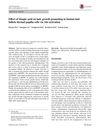Anti-oxidant and Anti-inflammatory Effects of Sinapic Acid in UVB Irradiation-Damaged HaCaT Keratinocytes
November 2017
in “
Asian Journal of Beauty and Cosmetology
”
TLDR Sinapic acid may protect skin cells from UV damage and reduce inflammation, making it a promising anti-aging cosmetic ingredient.
The study investigated the antioxidant and anti-inflammatory effects of sinapic acid on UVB-damaged HaCaT keratinocytes to assess its potential as an anti-aging cosmetic ingredient. Sinapic acid was found to protect cells from UVB-induced cytotoxicity and reduce reactive oxygen species (ROS) production. It increased the expression of antioxidant-related genes such as SOD1, CAT, GPX1, NRF2, and HO1, while decreasing lipid peroxidation in a concentration-dependent manner. Additionally, it reduced the expression of inflammation-related genes COX2, IL6, and IL8. These findings suggested that sinapic acid had promising potential as an anti-aging cosmetic component.
